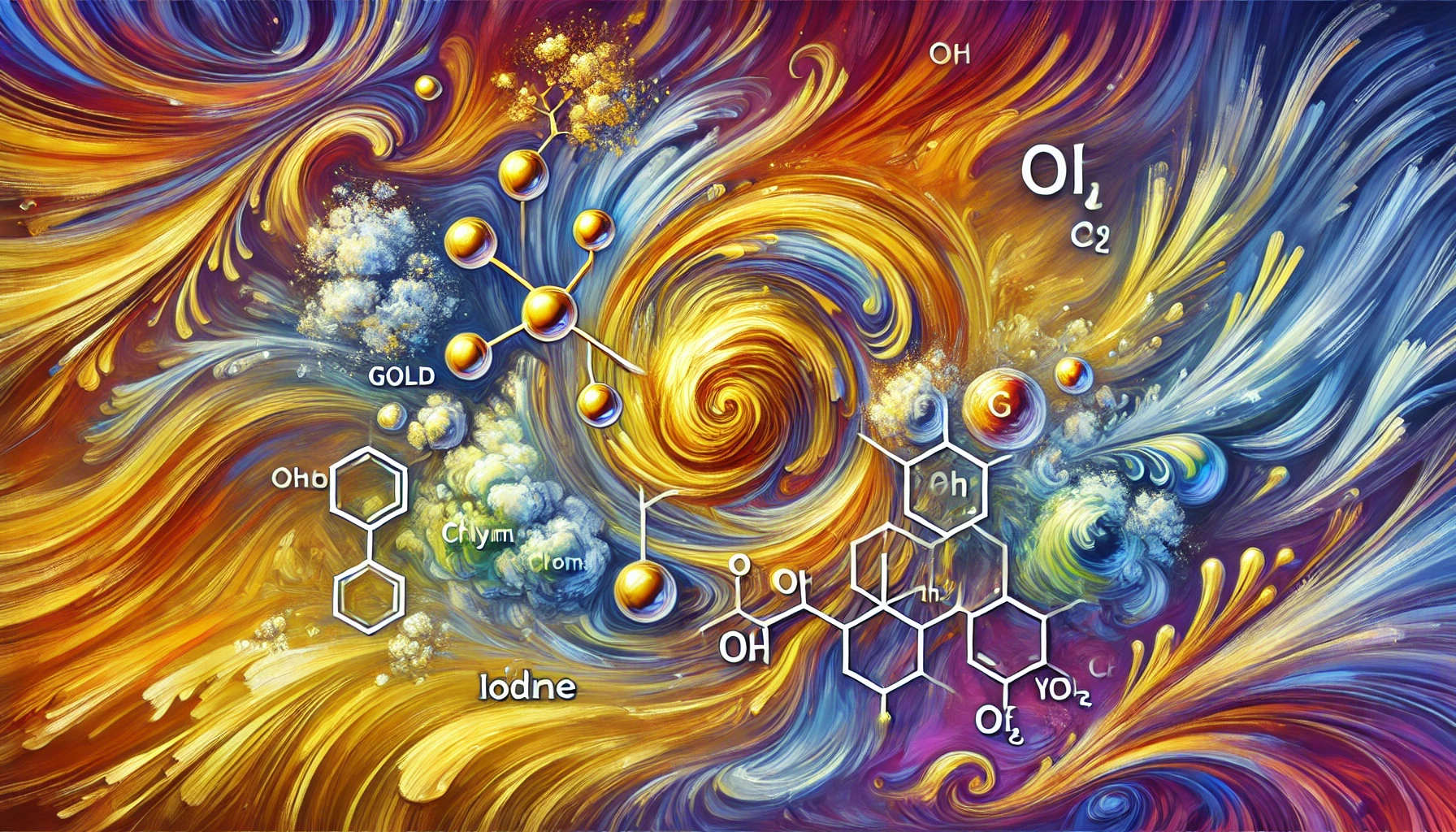Table of contents
Industry & Commodities
Gold in industry: A detailed analysis of its interactions with halogens and in cyanide solutions
Dr. Mathias Kunze
Senior Consultant in Commercial and Tax Law
10 min.
Published on: 17.12.2024 | 00:40 UTC
Updated on:
16.01.2025 | 11:22 UTC

Interaction of gold with halogens and cyanides as crucial reactions in industrial processes
Source: ChatGPT (OpenAI)
Gold exhibits important chemical properties when reacting with halogens and in cyanide solutions, which must be taken into account in industrial manufacturing processes. A lack of care can therefore lead to considerable consequences, the consequences of which are often underestimated in the industry.
Gold: A precious metal with unexpected chemical dynamics
Gold has been at the center of economic, technological and cultural developments for centuries. As a precious metal of the highest purity and exceptional stability, it is considered virtually indestructible and, in a chemical context, inert. However, this supposed inertia is put into perspective on closer analysis, as gold shows remarkable reactivity under specific conditions.
For example, when interacting with halogens such as chlorine, bromine and iodine, gold develops a chemical dynamic that is of central importance for industrial processes. Its solubility in cyanide solutions is also a key element of modern processing methods. These properties have far-reaching consequences for the industry, as they not only influence the efficiency of gold extraction, but also have a significant impact on the safety of processes.
The consideration of these chemical processes is therefore highly relevant in industrial practice. A deeper understanding of the underlying mechanisms is not only essential for the optimization of industrial processes, but also for the avoidance of risks that can result from a lack of consideration of these properties. Gold is therefore not only a synonym for durability, but also a raw material whose chemical reactions play a key role in modern industrial applications.
The chemical nature of gold: Focus on stability and reactivity
Stability and inertness: The dual nature of gold
Gold is valued for its exceptional resistance. It resists corrosion, does not tarnish and remains unchanged even under adverse environmental conditions. The precious metal owes this stability to its unique electronic structure, in particular the complete occupation of the d orbitals, which protects it from oxidation.
This chemical inertia is clearly evident in everyday life: neither atmospheric oxygen nor water attack gold, which has made it a symbol of resistance. Even many strong acids such as sulphuric or hydrochloric acid are unable to dissolve the precious metal. These properties explain why gold is indispensable in jewelry making and for long-term investments. However, it is precisely this inertness that makes its reactivity in certain chemical processes all the more remarkable.
Reaction with halogens: Unexpected dynamics of a precious metal
Under conventional conditions, gold appears to be almost inert, but when it comes into contact with halogens such as chlorine, bromine and iodine, it develops an extraordinary reactivity. Halogens have a high electron affinity, which enables them to overcome the stable structure of gold and form chemical compounds with the metal. These reactions take place through oxidation of the gold and the formation of gold halides such as gold(III) chloride (AuCl₃) or gold(I) iodide (AuI).
The reactivity of gold varies depending on the halogen and the specific reaction conditions, which is of crucial importance in industrial manufacturing processes.
- Chlorine: At elevated temperatures or in the gas phase, gold reacts with elemental chlorine to form gold(III) chloride. This reaction can lead to unwanted by-products if it is not precisely controlled. This can affect the efficiency of the entire process. In the worst case, chlorine compounds can attack the system materials and cause corrosion damage.
- Bromine: Although the reaction with bromine is less energetic than that with chlorine, it is no less problematic. When bromine attacks gold, gold bromides are formed, which in many cases go into solution. A lack of control over the bromine concentration can lead to insufficient gold recovery, resulting in material losses and unnecessary costs.
- Iodine: The reaction with iodine, which can also take place in an alcoholic solution, forms gold(I) iodide. This reaction is particularly sensitive to exact concentrations and solvents. Incorrect handling can not only lead to insufficient yields, but also to dangerous vapors that pose a health risk to production personnel.
All the reactions described above require precise control, as even minor deviations in conditions such as fluctuations in the concentration of halogens or inadequate temperature regulation can lead to undesirable side reactions. For example, unstable intermediates can be formed which slow down the reaction or reduce the desired solubility of the gold. These disturbances not only impair the efficiency of the processes, but can also lead to corrosion of processing equipment. This is particularly evident when aggressive halogen compounds are produced in uncontrolled quantities.
In addition, there is a considerable safety risk due to the release of highly reactive or toxic halogen vapors such as chlorine gas or bromine gas, which can occur under certain conditions. These compounds not only pose a danger to operating personnel, but can also pollute the environment if they are inadequately discharged or filtered. Careful monitoring and control of these processes is therefore essential to ensure safe and effective industrial processing.
Solubility in cyanide solutions: Precise control for safe processes
Another critical factor in numerous industrial processes is the solubility of gold in cyanide solutions, in which the precious metal is extracted from ores or recycled. Gold reacts in cyanide solutions to form potassium dicyanidoaurate. This is a stable compound that is used for the subsequent recovery of the metal. However, this process is only efficient and safe under precisely controlled conditions. Incorrect control of the cyanide concentration or inadequate monitoring of the solvent ratios can lead to incomplete dissolution of the gold, resulting in both material losses and lower output. Inaccurate dosing can also trigger dangerous chemical reactions, which not only reduce the yield but can also increase the risk of toxic cyanide gases. These gases pose a significant risk to the safety of production workers and the environment.
In addition, improper handling of cyanide solutions can lead to corrosion damage to the equipment, jeopardizing operational stability and causing unexpected maintenance costs. Therefore, precise and continuous monitoring of all process parameters is essential to ensure both efficiency and safety in gold processing.
Optimization and risk management in gold processing
Precision control: The key to efficiency and safety
The reactions of gold with halogens and its solubility in cyanide solutions require a high degree of precision control in order to maximize both the efficiency and safety of production processes. Continuous monitoring of halogen concentrations is therefore necessary, as even minor fluctuations can lead to undesirable side reactions. Automated dosing systems and high-precision sensors measure the concentrations in real time to prevent material losses and corrosion damage. Temperature also plays a crucial role, as too high or too low a temperature can impair the reaction rate. Precise heating and cooling systems coordinate a constant temperature distribution, while temperature sensors make automatic adjustments to ensure the stability of the process.
In cyanide leaching, the correct cyanide concentration is critical for gold extraction. Electronic control systems continuously monitor the cyanide content and pH value and adjust them as necessary to achieve optimal gold extraction and prevent the formation of toxic vapors. The use of catalysts to optimize the reaction rate and inhibitors to prevent unwanted side reactions is also of great importance. Automated dosing systems ensure that the quantity of added substances is precisely controlled.
Use of innovative technologies to control unwanted gold reactions
The interaction of gold with halogens and solubility in cyanide solutions present complex chemical challenges. Modern technologies have the ability to precisely control such processes, improving both the efficiency and safety of gold processing.
- Automated dosing systems and real-time sensor technology are critical to keeping track of the exact concentrations of halogens and cyanides. These systems automatically adjust the feed of these chemicals based on continuous measurements to ensure optimal reaction conditions and minimize the risk of unwanted side reactions.
- In-line spectroscopy provides continuous monitoring of the chemical composition during reactions. This technology enables a rapid response to any deviations, which is crucial to ensure the integrity of the manufacturing process and prevent the formation of hazardous by-products.
- Machine learning algorithms evaluate the extensive data from the production processes. They identify patterns that indicate potential for optimization and automatically adjust the process parameters to increase efficiency and reduce resource consumption and environmental impact.
- Artificial intelligence in process control uses advanced models to predict and avoid disruptions. By continuously adjusting process conditions, AI-controlled systems can guarantee that gold is processed under ideal conditions and the risk of errors is significantly reduced.
These technological advances play a key role in the safe and efficient processing of gold when handling reactive chemicals. They ensure that the critical chemical properties of gold are adequately addressed to avoid the scope of potential consequences of a lack of care.
Risk management: Safety protocols and emergency strategies
Efficient risk management in gold processing requires clear safety protocols that are tailored to the specific hazards of the chemical reactions. The key components of these protocols include the hazard analysis, which identifies all risks such as toxic vapors or corrosion hazards as well as risk mitigation measures. These include the use of gas filtration systems and closed circuits to prevent hazardous halogen gases. Regular maintenance and functional checks of these systems are required to prevent leaks.
Safety protocols must also include all staff training to ensure the safe handling of hazardous chemicals. Personal protective equipment (PPE) such as respirators and protective suits must be available at all times. Emergency plans must also set out clear procedures for evacuation and first aid. In the event of a chemical release, access to the affected zone must be prevented immediately and staff must be equipped with emergency kits.
Alarm and reporting systems are essential in order to be able to take immediate action if dangerous chemical concentrations are exceeded. These systems should automatically stop the supply of chemicals and activate ventilation units if necessary. After an incident, a follow-up investigation is required to identify weaknesses in safety management and minimize future risks.
Future avoidance of detrimental halogen and cyanide reactions with gold
Modern technologies already enable precise control of gold reactions with halogens and in cyanide solutions. However, the focus is on future innovations that could eliminate undesirable chemical halogen and cyanide reactions in gold processing through completely new approaches. These primarily include the following approaches:
- Development of non-toxic reaction media: research is aimed at replacing halogens and cyanides with more environmentally friendly as well as less toxic substances. These new media could reduce environmental impact while improving safety standards for the workforce.
- Improving real-time analytics: The next generation of in-line analytics will include sensors that are even more powerful and sensitive. These can monitor chemical processes more precisely and increase the safety and efficiency of processes through immediate adjustments.
- Integration of quantum computing: Quantum computing could transform data processing and data analysis in gold processing. It offers the opportunity to decipher the molecular complexity of chemical reactions and develop advanced optimization strategies.
- Advanced AI applications: Advanced artificial intelligence applications will occupy a key position. In particular, systems based on predictive analytics and machine learning will be developed to implement proactive control measures.
Research is increasingly focusing on minimizing the undesirable reactions of gold with halogens and cyanides through advanced technologies. The development of alternative and environmentally friendly reaction media as well as more precise analytical methods and intelligent control systems aims to make these specific chemical processes safer and more efficient. These efforts will not only help to reduce risks and environmental impact, but will also bring the use of gold in industrial applications into line with stricter environmental and safety standards.
Dr. Mathias Kunze
Senior Consultant in Commercial and Tax Law
Blog

All-time high: Gold price breaks through USD 3,000 for the first time

Precious metals as a security strategy to minimize corporate risks







